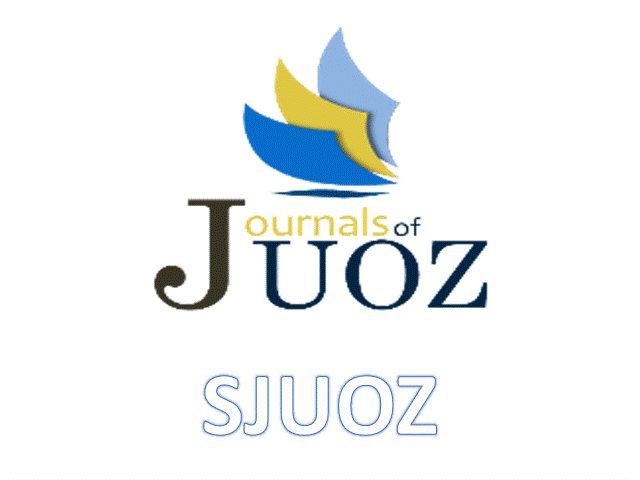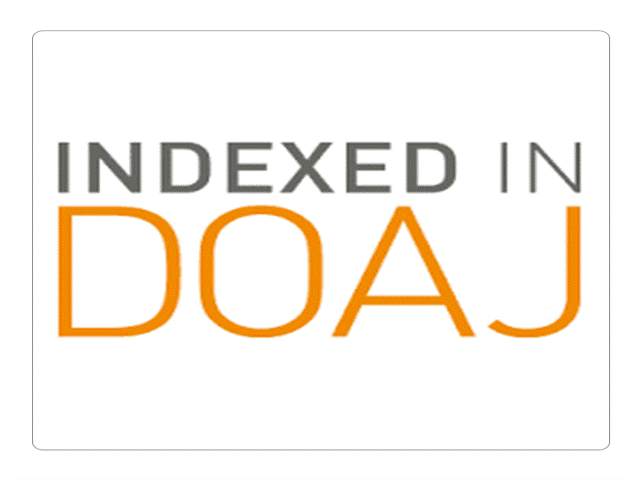Frequency of Selenomonas noxia in Oral Microbiota of Obese and Normal Weight People in Duhok-Iraq
DOI:
https://doi.org/10.25271/sjuoz.2019.7.4.674Keywords:
Obesity;, Selenomonas noxia;, BMI, Duhok, IraqAbstract
Obesity represents one of the major problematic health issues worldwide. Recent evidences suggest that obesity is related with the alteration of the oral microbiome. The aim of this study was to measure the salivary bacterial Selenomonas noxia in Duhok population. A total of 155 saliva samples were collected from individuals (aged between 19-35 years) of both genders (86 females and 69 males). The individuals were divided into three groups (obese, overweight, and normal weight) based on their body mass index. Bacterial genomic DNA was extracted from saliva samples. Molecular detections of Selenomonas noxia were performed by the polymerase chain reaction. Among the 155 participants, 34.1% were obese, 26.4% overweight and 39.3% normal weight individuals. The prevalence rate of oral S. noxia among all people was 82.6%. The highest rate of S. noxia was in obese people (86.8%), followed by overweight (85.4%) and normal weight people (77%). The prevalence of S. noxia in overweight people was statistically significant in compare with the normal weight people (p<0.0001). Moreover, the oral carriage of S. noxia was highest among the overweight females (94.5%) followed by obese females (88.9%). However, no significant difference was found compared to males. The result revealed that it is possible to assume that the expansion of S. noxia in saliva is due to obesity. Moreover, the composition of salivary microbiome may lead to the risk that the overweight group is at risk of future obesity. However, further investigations are required with larger sample and participants with different socioeconomic status in order to address the exact link between obesity and oral bacteria. This could lead to a new and promising therapeutic way for improving human's health.
Downloads
References
Abkar, F.; Rahman, S.; Naveed, A.; Rasheed, H. and Mehfooz, S.A. 2019. Evaluation of oral microflora in obese and non-obese humans from district Faisalabad, Pakistan. Curr Res Diabetes Obes J, 10.
Ahima, R.S. and Flier, J.S. 2000. Annual review of physiology. Leptin, 62: 413-443.
Alabdulkarim, M.; Bissada, N.; Al-Zahrani, M.; Ficara, A. and Siegel, B. 2005. Alveolar bone loss in obese subjects. J Int Acad Periodontol, 7: 34-38.
Bouchard, C. and Tremblay, A. 1990. Genetic effects in human energy expenditure components. Int J Obes, 14 Suppl 1: 49-55; discussion 55-48.
Boutaga, K.; Savelkoul, P.H.; Winkel, E.G. and van Winkelhoff, A.J. 2007. Comparison of subgingival bacterial sampling with oral lavage for detection and quantification of periodontal pathogens by real-time polymerase chain reaction. J Periodontol, 78: 79-86.
Bui, Q.; Nguyen, C.; McDaniel, J.; McDaniel, S.; Kingsley, K. and Howard, K.M. 2017. Selenomonas noxia Screening among Pediatric Patient Samples: A Pilot Study. J Oral Health Dent Care, 1: 009.
Craig, R.G.; Boylan, R.; Yip, J.; Bamgboye, P.; Koutsoukos, J.; Mijares, D.,Haffajee, A.D. 2001. Prevalence and risk indicators for destructive periodontal diseases in 3 urban American minority populations. J Clin Periodontol, 28: 524-535.
Cruz, P.; Mehretu, A.M.; Buttner, M.P.; Trice, T. and Howard, K.M. 2015. Development of a polymerase chain reaction assay for the rapid detection of the oral pathogenic bacterium, Selenomonas noxia. BMC Oral Health, 15: 95.
DiBaise, J.K.; Zhang, H.; Crowell, M.D.; Krajmalnik-Brown, R.; Decker, G.A. and Rittmann, B.E. 2008. Gut microbiota and its possible relationship with obesity. Mayo Clin Proc, 83: 460-469.
Ellekilde, M.; Selfjord, E.; Larsen, C.S.; Jakesevic, M.; Rune, I.; Tranberg, B.,Hansen, C.H. 2014. Transfer of gut microbiota from lean and obese mice to antibiotic-treated mice. Sci Rep, 4: 5922.
Goodson, J.M.; Groppo, D.; Halem, S. and Carpino, E. 2009. Is obesity an oral bacterial disease? Journal of dental research, 88: 519-523.
Hotamisligil, G.S. 2006. Inflammation and metabolic disorders. Nature, 444: 860-867.
Hruby, A. and Hu, F.B. 2015. The Epidemiology of Obesity: A Big Picture. Pharmacoeconomics, 33: 673-689.
Iwamoto, Y.; Nishimura, F.; Nakagawa, M.; Sugimoto, H.; Shikata, K.; Makino, H.,Murayama, Y. 2001. The effect of antimicrobial periodontal treatment on circulating tumor necrosis factor-alpha and glycated hemoglobin level in patients with type 2 diabetes. J Periodontol, 72: 774-778.
Jeelani, A.; Ahmed, S.A. and Momin, F.V. 2013. Obesity-Caused by a germ. International Journal of Scientific and Research Publications, 3: 1-3.
Koliada, A.; Syzenko, G.; Moseiko, V.; Budovska, L.; Puchkov, K.; Perederiy, V.,Vaiserman, A. 2017. Association between body mass index and Firmicutes/Bacteroidetes ratio in an adult Ukrainian population. BMC Microbiol, 17: 120.
Komaroff, M. 2016. For Researchers on Obesity: Historical Review of Extra Body Weight Definitions. J Obes, 2016: 2460285.
Ley, R.E.; Backhed, F.; Turnbaugh, P.; Lozupone, C.A.; Knight, R.D. and Gordon, J.I. 2005. Obesity alters gut microbial ecology. Proc Natl Acad Sci USA, 102: 11070-11075.
Makkar, H.; Reynolds, M.A.; Wadhawan, A.; Dagdag, A.; Merchant, A.T. and Postolache, T.T. 2018. Periodontal, metabolic, and cardiovascular disease: Exploring the role of inflammation and mental health. Pteridines, 29: 124-163.
Mazumdar, V.; Snitkin, E.S.; Amar, S. and Segre, D. 2009. Metabolic network model of a human oral pathogen. J Bacteriol, 191: 74-90.
McDermott, I. 2016. Exploring a possible correlation between the human oral microbiome and body mass index University of Colorado, Boulder. Theses.
Moore, L.; Johnson, J. and Moore, W. 1987. Selenomonas noxia sp. nov., Selenomonas flueggei sp. nov., Selenomonas infelix sp. nov., Selenomonas dianae sp. nov., and Selenomonas artemidis sp. nov. from the Human Gingival Crevice. International Journal of Systemic Bacteriology, 36: 271-280.
Moreno-Indias, I.; Cardona, F.; Tinahones, F.J. and Queipo-Ortuno, M.I. 2014. Impact of the gut microbiota on the development of obesity and type 2 diabetes mellitus. Front Microbiol, 5: 190.
Ouchi, N.; Parker, J.L.; Lugus, J.J. and Walsh, K. 2011. Adipokines in inflammation and metabolic disease. Nat Rev Immunol, 11: 85-97.
Piombino, P.; Genovese, A.; Esposito, S.; Moio, L.; Cutolo, P.P.; Chambery, A.,Ercolini, D. 2014. Saliva from obese individuals suppresses the release of aroma compounds from wine. PLoS One, 9: e85611.
Rothschild, D.; Weissbrod, O.; Barkan, E.; Kurilshikov, A.; Korem, T.; Zeevi, D.,Segal, E. 2018. Environment dominates over host genetics in shaping human gut microbiota. Nature, 555: 210-215.
Socransky, S.S. and Haffajee, A.D. 2005. Periodontal microbial ecology. Periodontol 2000, 38: 135-187.
Takeshita, T.; Kageyama, S.; Furuta, M.; Tsuboi, H.; Takeuchi, K.; Shibata, Y.,Yamashita, Y. 2016. Bacterial diversity in saliva and oral health-related conditions: the Hisayama Study. Sci Rep, 6: 22164.
Tehrani, A.B.; Nezami, B.G.; Gewirtz, A. and Srinivasan, S. 2012. Obesity and its associated disease: a role for microbiota? Neurogastroenterol Motil, 24: 305-311.
WHO 2018. World health organization . Obesity and overweight. (https://www.who.int/news-room/fact-sheets/detail/obesity-and-overweight. 5/10/2019 2019;
Williams, L.M. 2012. Hypothalamic dysfunction in obesity. Proc Nutr Soc, 71: 521-533.
Wu, Y.; Chi, X.; Zhang, Q.; Chen, F. and Deng, X. 2018. Characterization of the salivary microbiome in people with obesity. Peer J, 6: e4458.
Zeigler, C.C.; Persson, G.R.; Wondimu, B.; Marcus, C.; Sobko, T. and Modeer, T. 2012. Microbiota in the oral subgingival biofilm is associated with obesity in adolescence. Obesity (Silver Spring), 20: 157-164.
Downloads
Published
How to Cite
Issue
Section
License
Copyright (c) 2019 Roshna M. Qadir, Mahde S. Abdulrahman

This work is licensed under a Creative Commons Attribution 4.0 International License.
Authors who publish with this journal agree to the following terms:
- Authors retain copyright and grant the journal right of first publication with the work simultaneously licensed under a Creative Commons Attribution License [CC BY-NC-SA 4.0] that allows others to share the work with an acknowledgment of the work's authorship and initial publication in this journal.
- Authors are able to enter into separate, additional contractual arrangements for the non-exclusive distribution of the journal's published version of the work, with an acknowledgment of its initial publication in this journal.
- Authors are permitted and encouraged to post their work online.








